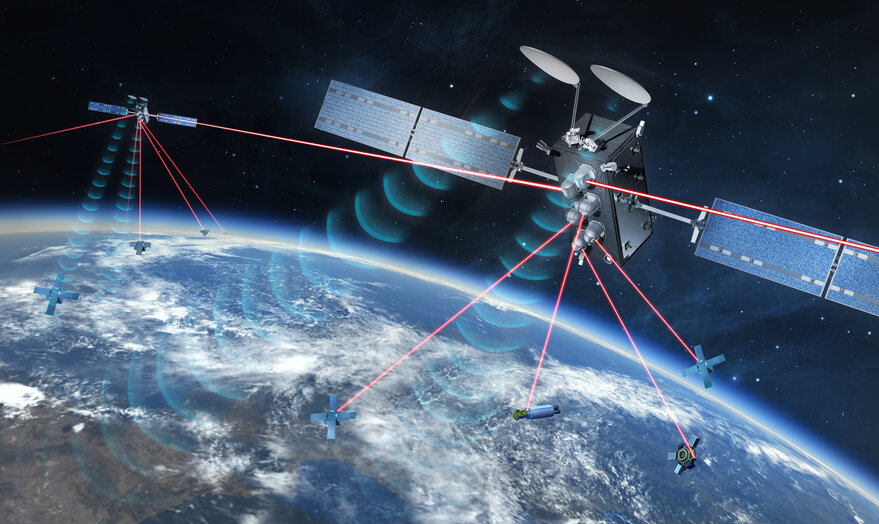SAN FRANCISCO – SpaceLink has awarded OHB System AG a contract with an anticipated value of more than $300 million to manufacture four satellites for its commercial space data relay constellation.
After reviewing proposals from multiple satellite manufacturers, SpaceLink selected OHB based on a number of factors including the German company’s experience building Galileo navigation satellites for medium Earth orbit.
“They’ve done optical and onboard processing before, so they’re ideal for us in terms of having relevant experience in all of the key technologies,” Tony Colucci, SpaceLink chief strategy and commercial officer, told SpaceNews. “Also, they have a good reputation for delivering on schedule, which is another important factor for us. Obviously, we want to get our revenue started as soon as we can.”
OHB announced plans to invest $25 million investment in SpaceLink, making OHB “the cornerstone investor in the initial round of financing for the project,” according to an Oct. 13 news release.
“For SpaceLink, we are providing a highly reliable and cost-effective solution based on our modular satellite platform, which has been successfully proven on multiple critical missions,” Marco Fuchs, OHB SE CEO, said in a statement. “We look forward to working together with the SpaceLink team to help launch this important resource for real-time space connectivity.”
McLean, Virginia-based SpaceLink plans to establish a relay network in medium Earth orbit to connect commercial and government satellites with customer mission operations centers. Customers with satellites in low Earth orbit will relay RF and optical data through SpaceLink’s medium Earth orbit constellation to and from ground stations. SpaceLink satellites will be equipped with laser crosslinks to route data traffic quickly through the network.
“That space economy is literally mushrooming [and] the bottleneck of communications between LEO and the ground is becoming more and more a problem,” Colucci said. “As that economy evolves, the need to have real-time and high-bandwidth communications increases.”
SpaceLink’s initial constellation requires three satellites to provide global coverage. The company plans to launch four satellites to provide on-orbit redundancy. SpaceLink satellites are scheduled to begin launching in 2024, but the company has not yet decided whether to send them to orbit on a single rocket.
“There are advantages to launching all at once, from getting the whole system up and operating at the same time, and costs advantages for one launch over two,” Colucci said. “And then of course you always have to trade off putting all your eggs in one basket.”
Under SpaceLinks’ agreement with OHB, roughly half of the satellite subsystems and components will come from U.S. suppliers.
“For Space Link, our customer base will be a mix of commercial and government customers, and not just U.S. government, but we anticipate allied governments will ultimately use the services as well,” Colucci said.
SpaceLink expects more than half the data carried by its network, whether it originates from commercial satellites or from government satellites, to flow to government end users.
“There are, of course, certain security requirements involved there,” Colucci said. “Having key payload technologies and equipment that’s manufactured in the U.S. just makes that a simpler case for the U.S. players.”
As soon as SpaceLink selected OHB, the two companies “commenced a co-engineering effort in Germany to finalize the satellite design,” SpaceLink CEO Dave Bettinger said by email. “The design is significantly improved from earlier versions due to the talent and experience of the combined SpaceLink and OHB team. Our customers are very excited and we are working with several of them to integrate optical intersatellite links on their spacecraft.”
SpaceLink is financing its initial constellation through equity.
“For a project like this there’s a substantial amount of equity required before debt comes in,” Colucci said. “We expect to bring in some debt, probably in the 2023-2024 timeframe, but this year and next we’ll be financing it through rounds of equity.”
In many satellite constellations, though certainly not every deal, manufacturers like OHB sign on as strategic investors, Colucci said. Sometimes other constellation partners also become strategic investors, “but in our case we’re trying to keep this to a minimum … because, of course, we already have EOS. OHB and EOS have a long-standing close relationship, so this one just seemed to be a good fit.”
On the regulatory side, SpaceLink “remains on track” to meet its 2024 Federal Communications Commission license deadline, Bettinger said. SpaceLink’s International Telecommunications Union spectrum filings do not expire until 2028.
Australia’s Electro Optic Systems Holdings Ltd. (EOS) announced plans in 2020 to spend approximately $1.2 billion Australian dollars (about $800 million at the time) to create the SpaceLink constellation.
OHB built 34 Galileo navigation satellites, which operate in medium Earth orbit. The company based in Bremen, Germany, also manufactured the European Data Relay System-C, a geostationary satellite with RF and optical communications payloads.
